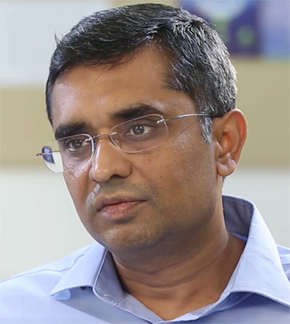AI in the Medical Domain: Not a Quick Fix
Danish Gupta discuss the current strengths and weaknesses of artificial intelligence applications in life sciences.
Manish Gupta

Much as blockchain and 3D printing have become part of the lexicon in the Fourth Industrial Revolution, artificial intelligence (AI) is another hugely visible, discussed, and debated application predicted to deliver a healthcare revolution-from aiding drug discovery, diagnostics, patient engagement, to adverse event detection.
That’s the good news. What’s not so good is that there are significant associated risks, which, if not appropriately and immediately addressed, might delay the benefits that AI has to offer, especially in the medical domain in life sciences. Medical domain deals with data heterogeneity. So far, AI has been deployed in visual and numerical applications of data only in pilots for visual diagnostics, medical record mining, and biostatistics. The success in these pilots only warrants a deeper evaluation of AI before mass hysteria takes over.
The application of AI in textual data (from varied sources such as biomedical literature, social media, web-search logs, etc) in a number of life sciences processes such as pharmacovigilance, safety, medical writing, product labeling, etc, sees far fewer success stories, with significantly limited scope. The reasons are not too difficult to see. Clinical context and interpretation are critical to sensibly process medical content, whether it be voice/speech to text, data extraction from unstructured or semi-structured sources, medical bots, structured content authoring, etc. This implies that AI and contemporary technologies by themselves are not enough. Contextualizing these technologies with nuanced medical expertise is important, something that the industry has started to see for themselves. For example, accurately contextualizing the treatment drug versus the suspect drug/concomitant medication, indication/symptoms versus adverse event, etc, needs the right level of medical/clinical understanding and application that only human clinical expertise can bring.
There are, however, areas where AI is having an immediate and significant impact. AI can be contextualized and customized for real-time voice/speech-to-text conversions to drive both efficiency and efficacy of safety/medical information/product quality complaint case intake. Similarly, data extraction and auto-population of data from structured, semi-structured, and unstructured sources in case processing is another area that has tremendous potential for AI, driving higher quality and regulatory compliance outcomes at significantly reduced efforts and time.
The application can have much broader, wider, and deeper impacts in other areas. For example, the industry is exploring AI-led technologies for response generation of medical queries and search and retrieval of document/information from content repositories, significantly navigating multiple sources of truth to provide accurate and appropriate responses, impacting the effectiveness and efficiency of the medical information process. This has the potential over time to perhaps evolve into being the medical Siri/Alexa.
One of the truly exciting areas is the potential for AI to transform document authoring and management, which can potentially impact the creation and maintenance of a number of regulatory/medical/clinical/safety documents by leveraging machine-assisted intelligent document classification, indexing, and tagging; machine-enabled deconstruction of documents into components; business-rules–driven reassembly of components for authoring of new documents; and accurate automatic update(s) of new information in the output/dependent documents. This would positively impact the effectiveness and efficiency of authoring and submission processes and shorten the time-to-agency.
So, should AI take the mantle of the next superhero in the medical domain? Only long-drawn relationships, deep interpretation of raw textual data, and real-world application hold the key to answering this question. There are only very few quick fixes, and organizations will have to combine AI with human medical expertise. Over time, the involvement of human expertise may taper, but is not likely to cause major redundancies in this space. Process automation will only complement domain expertise for players in this area.
Organizations having disproportionate expectations and expecting unrealistic benefits in the immediate-term by utopian promises of pure-play technology, in the absence of sufficient medical relevance, will most likely be in for disappointment. Reasonable calibration of expectations and measured journeys of making technology medically relevant on context and interpretations hold the key to unshackling the superhero in AI, especially in the medical domain.
Manish Gupta is co-founder and CEO of Indegene, a global healthcare solutions provider.
Is Artificial Intelligence a ‘Product’? Products Liability Implications for AI-Based Products
April 10th 2025As the physical products we use evolve to become increasingly complex, traditional products liability frameworks may not always fit to provide remedies for harm that can result from using novel product types.